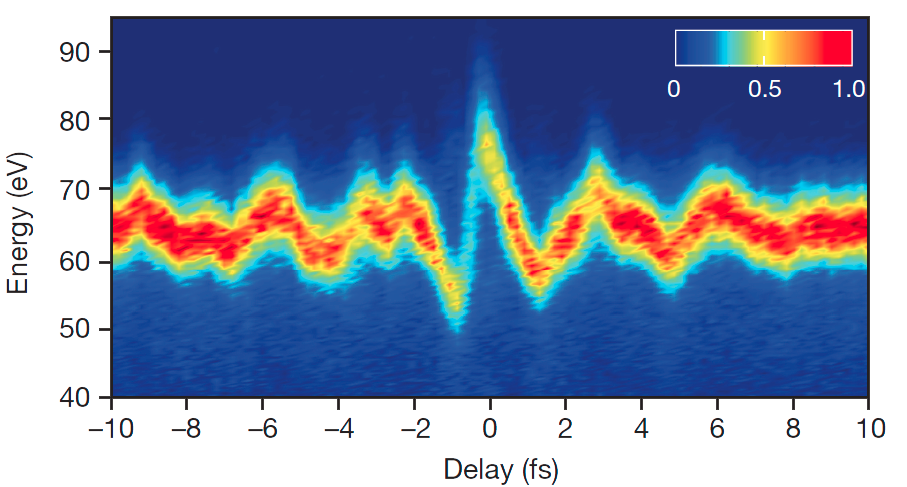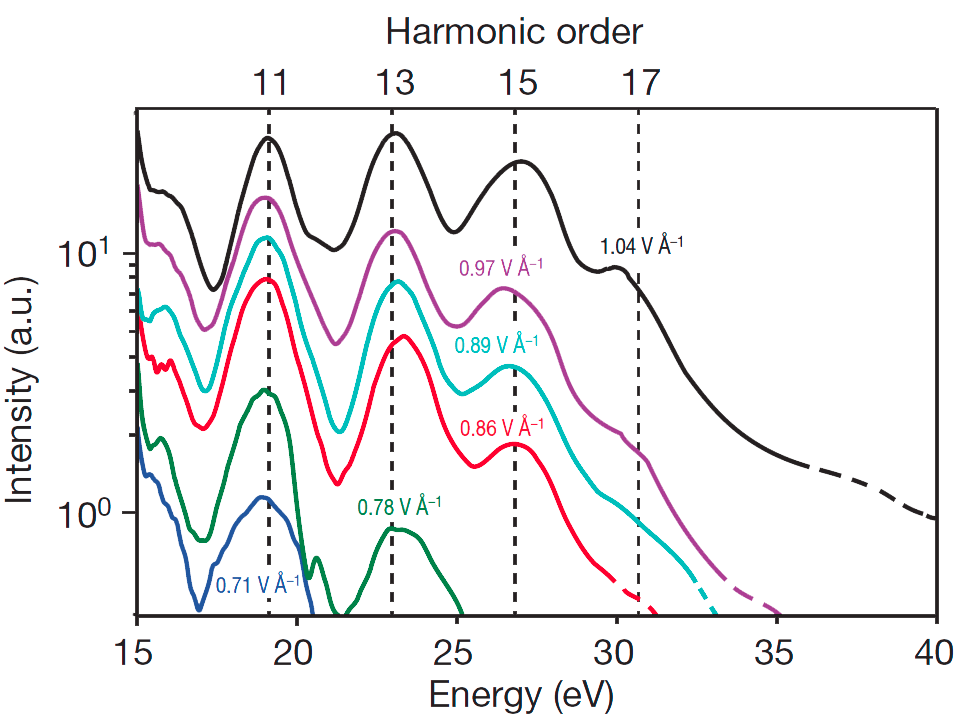Visual observation, the most ubiquitous form of light-matter interaction, happens in the human time scale. In order to perform observation of dynamics in progressively faster time scales, for instance, protein motions, proton transfer, rotational, vibrational, electronic dynamics, we need tools that are equivalent or faster. Ultimately, if one wants to investigate electronic dynamics which are extremely fast, laser pulses whose duration is at the order of femtoseconds or attoseconds would be desired. One femtosecond is one millionth billionth of a second (1 fs = 10-15 s) and one attosecond is one thousandth of one femtosecond (1 as = 10-18 s). In our group, we are seeking to generate, measure, and develop new methodologies in creation of ultrashort laser pulses. All of our studies are based on nonlinear optics and strong-field laser physics. Below are among few of our research directions.
Generation and measurement of ultrafast (femtosecond-attosecond) laser pulses
 The time it takes a bound electron to respond to the electromagnetic force of light sets a
fundamental speed limit on the dynamic control of matter and electromagnetic signal processing.
Time-integrated measurements of the nonlinear refractive index of matter indicate that the
nonlinear response of bound electrons to optical fields is not instantaneous;
however, a complete spectral characterization of the nonlinear susceptibility tensors—which
is essential to deduce the temporal response of a medium to arbitrary driving forces using
spectral measurements—has not yet been achieved. Here we demonstrate
that intense optical attosecond pulses synthesized in the visible and nearby spectral ranges
allow sub-femtosecond control and metrology of bound-electron dynamics. Vacuum ultraviolet
spectra emanating from krypton atoms, exposed to intense waveform-controlled optical attosecond
pulses, reveal a finite nonlinear response time of bound electrons of up to 115 attoseconds,
which is sensitive to and controllable by the super-octave optical field. Our study could enable
new spectroscopies of bound electrons in atomic, molecular or lattice potentials of solids,
as well as light-based electronics operating on sub-femtosecond timescales and at petahertz rates.
The time it takes a bound electron to respond to the electromagnetic force of light sets a
fundamental speed limit on the dynamic control of matter and electromagnetic signal processing.
Time-integrated measurements of the nonlinear refractive index of matter indicate that the
nonlinear response of bound electrons to optical fields is not instantaneous;
however, a complete spectral characterization of the nonlinear susceptibility tensors—which
is essential to deduce the temporal response of a medium to arbitrary driving forces using
spectral measurements—has not yet been achieved. Here we demonstrate
that intense optical attosecond pulses synthesized in the visible and nearby spectral ranges
allow sub-femtosecond control and metrology of bound-electron dynamics. Vacuum ultraviolet
spectra emanating from krypton atoms, exposed to intense waveform-controlled optical attosecond
pulses, reveal a finite nonlinear response time of bound electrons of up to 115 attoseconds,
which is sensitive to and controllable by the super-octave optical field. Our study could enable
new spectroscopies of bound electrons in atomic, molecular or lattice potentials of solids,
as well as light-based electronics operating on sub-femtosecond timescales and at petahertz rates.
Related publications:
- M. Th. Hassan*, Tran Trung Luu*, A. Moulet, O. Raskazovskaya, P. Zhokhov, M. Garg, N. Karpowicz, A. M. Zheltikov, V. Pervak, F. Krausz & E. Goulielmakis. Optical attosecond pulses and tracking the nonlinear response of bound electrons, Nature, vol. 530, no. 7588, pp. 66- 70, (2016).
- M. Th. Hassan, A. Wirth, I. Grguras, A. Moulet, Tran Trung Luu, J. Gagnon, V. Pervak, E. Goulielmakis, Invited Article: Attosecond photonics: Synthesis and control of light transients, Review of Scientific Instruments, 83 (11), 111301-111301-19 (2012).
- A. Wirth, M. Th. Hassan, I. Grguras, J. Gagnon, A. Moulet, Tran Trung Luu, S. Pabst, R. Santra, Z.A. Alahmed, A.M. Azzeer, V.S. Yakovlev, V. Pervak, F. Krausz, E. Goulielmakis, Synthesized light transients, Science 334 (6053), 195-200 (2011).
Generation and measurement of high-order harmonics from condensed media

At the regime of low electric field strength, light-matter interaction results into only linear response of the media. When the electric field strength gets stronger, approaching the Coulomb force governing the dynamics of electrons, there would be perturbation to the standard Hamiltonian. The response of the quantum systems in this case will include a nonlinear response, a significant deviation from the linear response commonly found in daily life. When the electric field strength is increased to be equal to, or higher than the Coulomb potential, this is the regime of strong-field physics. In this interesting situation, the media response strongly to the incident electric field. As a result, ultrafast driven electronic dynamics give rise to the radiation of high energy photons, at multiples of the driving electric field frequency. These are high-order harmonics generated (HHG) from strong-field light-matter interaction.
Related publications:
- Tran Trung Luu*, M. Garg*, S. Y. Kruchinin, A. Moulet, M. T. Hassan, and E. Goulielmakis. Extreme ultraviolet high-harmonic spectroscopy of solids, Nature, vol. 521, no. 7553, pp. 498- 502, (2015).
- Tran Trung Luu*, Z. Yin*, A. Jain, T. Gaumnitz, Y. Pertot, J. Ma, H. J. Woerner, Extreme–ultraviolet high–harmonic generation in liquids, Nature Communications, vol. 9 (1), 3723, (2018).
- Tran Trung Luu, V. Scagnoli, S. Saha, L.J. Heyderman, H. J. Woerner, Generation of coherent extreme ultraviolet radiation from α–quartz using 50 fs laser pulses at a 1030 nm wavelength and high repetition rates, Optics Letters, vol. 43 (8), 1790-1793, (2018).
- Tran Trung Luu, H. J. Woerner, Measurement of the Berry curvature of solids using high-harmonic spectroscopy, Nature Communications, vol. 9 (1), 916, (2018).
- Tran Trung Luu, H. J. Woerner, High-order harmonic generation in solids: a unifying approach, Physical Review B, vol. 94 (11), 115164, (2016).